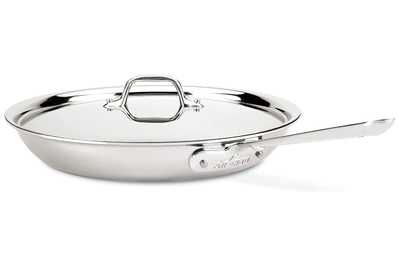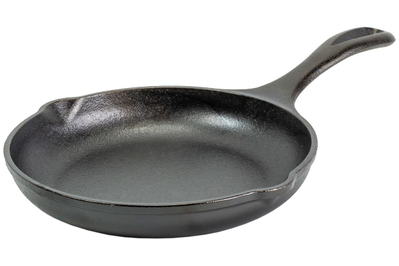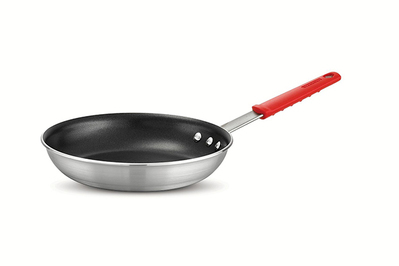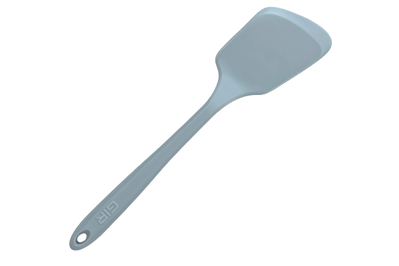Ask Wirecutter is an advice column that explores the best approaches to buying, using, and maintaining stuff.
Dear Wirecutter,
How bad is it to keep using old, scratched nonstick pans? Everyone in my household seems to think it’s fine and normal, but I’m worried. What do you think?
L.V.
Dear L.V.,
There are a few things here that we need to, um, unstick.
Although this is a wildly debated topic, our experts think that health risks from a scratched nonstick coating are low when used at the recommended low temperatures. But it does depend on how scratched the pan is—we recommend you stop using nonstick pans that are heavily scratched, or that are no longer nonstick. It also depends how old your pan is. Two of the major PFAS of concern, PFOA and PFOS, haven’t been used to make polytetrafluoroethylene (PTFE) nonstick coatings since 2014. Newer nonstick coatings use different PFAS whose health impacts are still being studied, but which appear to be safer.
You have good reason to be concerned about PFAS exposure in general. But for most of us, potential health impacts come from exposure that builds up from many sources over time (hence their “forever chemicals” nickname), rather than from using a single scratched pan. If you want to replace your nonstick cookware entirely with other types of pans, or want to limit your exposure to PFAS more broadly, there are some great options out there.
Alternatives to nonstick cookware
Nonstick pans can have a place in your cookware collection, but they shouldn’t be the only pans you use, and rotating in other cookware for your less delicate culinary adventures will help your nonstick pans last longer.
A good carbon steel pan is the Goldilocks of cookware: nonstick, lightweight, and affordable. The OXO Obsidian Series Carbon Steel Frypan is one of the only carbon steel pans we tested that’s slick enough to fry an egg without sticking right out of the box, according to our guide. This pan is high-quality enough that it can last you a lifetime, and you can even use metal utensils on it! What a dream.
A stainless steel skillet can go from stovetop to oven and is pretty easy to clean. The All-Clad D3 Stainless 12″ Fry Pan with Lid, for one, comes with a limited lifetime warranty. You can throw it in the dishwasher or use metal tools on it without worrying about scratching the surface, and it gives you the versatility to sear or sauté. You can read more in our guide to the best skillet.
Cast-iron skillets are great for high-heat cooking and can build a fairly nonstick surface through “seasoning,” which is a black protective layer of polymerized oil. They tend to be heavy, but our top pick, the Lodge Chef Collection 12 Inch Skillet, is 6½ pounds as opposed to 8½ for the classic Lodge skillet. Cast-iron pieces do need a bit of special attention to clean and season them properly, but they’ll last for generations (as opposed to a few years for a nonstick skillet). You can read more in our guide to the best cast-iron skillet.
If you want to buy a new nonstick pan
We advise replacing your nonstick pans whenever the coating starts to degrade or is scratched, or about every three to five years. Knowing that it’s not a buy-it-for-life thing, our kitchen team chose our top-pick nonstick pan, the Tramontina 10-Inch Professional Restaurant Fry Pan, based on its solid performance and relatively low price. If you have an induction cooktop, our also-great pick, the Tramontina Tri-Ply Base 10-Inch Nonstick Fry Pan, is induction-compatible.
If you’ve been intrigued by the Facebook and Instagram ads for the Our Place Always Pan and others like it, our experts say to keep scrolling. One of the reasons we don’t recommend it is that having to replace a $100-plus pan every few years doesn’t strike us as a good value. Also, ceramic nonstick coatings like the one on the Always Pan (which are made without PFAS) typically degrade even faster than PTFE.
We get the draw—these pans are beautiful, and for some people that’s a perfectly good reason to buy one. “But if you’re looking for cookware that will last—that’s high quality—this isn’t going to be it,” says supervising editor Marilyn Ong in our review of these pans.
How to take care of your nonstick pans
We have an entire section of our guide on this topic, as well as a video on how to clean your nonstick cookware. The TL;DR is don’t use nonstick cooking spray (ironically, it builds up over time and makes your pan prone to sticking), don’t put it in the dishwasher, don’t use metal tools (we like the GIR Mini Flip silicone spatula for nonstick cookware), and don’t overheat the pan.
Our experts believe that nonstick pans are likely safe to cook with if used at or below medium-low to medium on a stovetop range, but using searing high heat can degrade the nonstick coating, releasing fumes that can be toxic enough to kill birds.
The best thing you can do for your nonstick cookware is to pamper the heck out of it. A nonstick pan is for making creamy French omelets, fish fillets, crepes—not searing a steak. Anything you do that breaks down the nonstick coating will make the pan wear out faster.
Sometimes you can recycle nonstick pans through your local recycling service or, less preferably, drop them off at a scrapyard when you’re finished with them. My best advice is to thank those scratched babies for all of the great meals they’ve given you and your family—and then shuttle them right on out of the house.
This article was edited by Jason Chen and Ben Frumin. The update was edited by Alex Aciman and Katie Okamoto.








